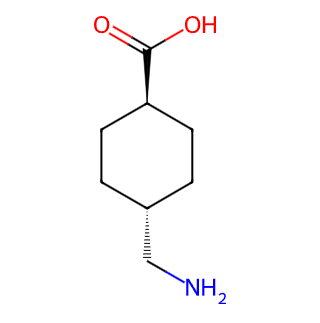- Synthetic anti-infective drugs
- Medications for the digestive system
- Antipyretic and analgesic drugs
- Medications for the blood system
- Medications for the respiratory system
- Anti-allergic drugs
- Medications for the urinary system
- Diagnostic medications
- Immunosuppressive and immunomodulatory drugs
- Vitamins and mineral supplements
- Antioxidants and medications for osteoporosis
- Antiparasitic drugs
- Ophthalmic medications
- Amino acids and their derivatives
- Dermatological medications
- Medications for the circulatory system
- Antitumor drugs
- Medications for the nervous system
- Hormonal and endocrine function-regulating drugs
- Antibiotics
- Others
CAS NO.: 1197-18-8




Tranexamic Acid
Basic Information
English Name: Tranexamic Acid
Alternative Names: Tranexamic Acid, Tranexamic, Amicar, Cyklokapron
Chemical Name: trans-4-Aminomethylcyclohexanecarboxylic Acid
Chemical Formula: C8H15NO2
Molecular Weight: 157.21
CAS Registry Number: 1197-18-8
EINECS Number: 214-818-2
Physical Properties
Appearance: White crystalline powder
Density: 1.095 g/cm³ (may vary slightly depending on measurement conditions; some sources report 1.096 g/cm³)
Boiling Point: 300.2 °C
Flash Point: 135.4 °C (some sources report 135.36 °C)
Solubility: Soluble in water, practically insoluble in ethanol, acetone, chloroform, or ether
Refractive Index: 1.497
Pharmacological Action
Tranexamic Acid is a synthetic lysine analog initially studied for hemostatic properties.
It acts by reversibly blocking the lysine-binding sites on plasminogen molecules, preventing the conversion of plasminogen to plasmin, thereby effectively inhibiting fibrinolysis and producing a hemostatic effect.
In addition to its hemostatic effects, Tranexamic Acid also inhibits the activity of melanocytes, reduces melanin production, exhibits anti-inflammatory, anti-allergic, and anti-aging properties against skin aging and photoaging.
Clinical Applications
Tranexamic Acid is widely used in the treatment of various bleeding disorders and abnormal bleeding during surgery, with notable effects in traumatic hemorrhage.
It is also applied in skin lightening by inhibiting the activity of tyrosinase, blocking the synthesis of melanin, and promoting its metabolism, leading to reduced pigmentation and brighter skin tone.
Storage Method
Tranexamic Acid should be stored in a light-protected, sealed container, out of reach of children.
It is typically recommended to store at 2°C to 8°C (36°F to 46°F) in a refrigerator to ensure drug activity and chemical stability.
In summary, Tranexamic Acid (Aminomethylcyclohexanecarboxylic Acid) is an organic compound with diverse pharmacological actions and extensive clinical applications.

Tai Yau Street, San Po Kong, Kowloon, Hong Kong, China.



